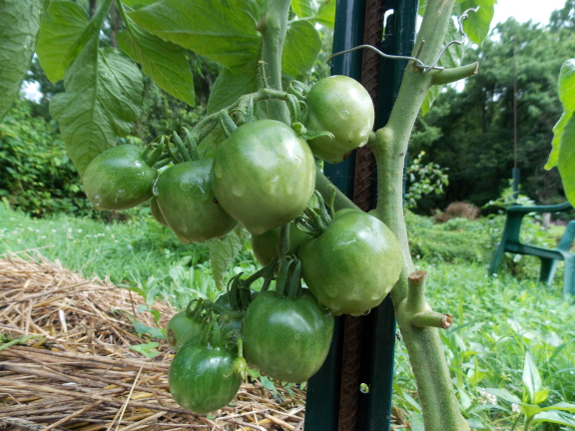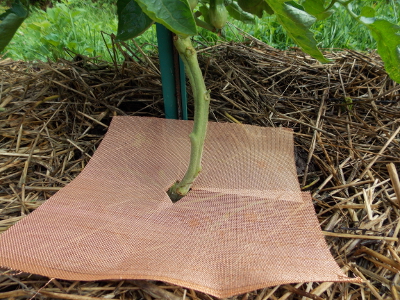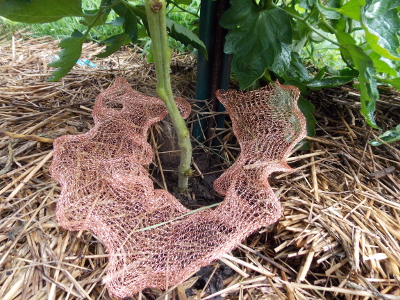
Fighting tomato blight with copper, revisited

The interest in Mark's
post about fighting tomato blight with pennies has been
astounding. Even though I'm dubious about pocket change's
effect on fungal diseases, that post's popularity made me decide
to experiment with a slightly different form of copper.
My budget for the
project was the $80 we've made in ad revenue from folks coming to
check out our tomato blight post, but I tacked on another $10 so I
could try two types of copper --- this
expensive and high-quality copper screen and this
ultra-cheap mesh.
Mark cut the screen into eight sections (each of which was a foot
square with a  notch to allow the screen to slide around the
tomato stem), and I cut the mesh into four lengths that cover
about the same area. My test subjects consisted of a row of
yellow romas, where I alternated control (no copper), mesh, and
screen beneath subsequent plants.
notch to allow the screen to slide around the
tomato stem), and I cut the mesh into four lengths that cover
about the same area. My test subjects consisted of a row of
yellow romas, where I alternated control (no copper), mesh, and
screen beneath subsequent plants.
The theory is that
the anti-fungal properties of copper will prevent fungal spores
from being splashed up from the soil line into the lower leaves
(where blight usually first takes hold of a tomato plant).
Organic farmers sometimes  use powdered copper on tomatoes for this
purpose, but that technique is dicey from a permaculture
standpoint since the powdered copper gets into the soil and kills
beneficial fungi as well as disease-causing species. Only
time will tell whether a solid copper mesh will serve the same
purpose without the harm to ecosystem life.
use powdered copper on tomatoes for this
purpose, but that technique is dicey from a permaculture
standpoint since the powdered copper gets into the soil and kills
beneficial fungi as well as disease-causing species. Only
time will tell whether a solid copper mesh will serve the same
purpose without the harm to ecosystem life.
Want more in-depth information? Browse through our books.
Or explore more posts by date or by subject.
About us: Anna Hess and Mark Hamilton spent over a decade living self-sufficiently in the mountains of Virginia before moving north to start over from scratch in the foothills of Ohio. They've experimented with permaculture, no-till gardening, trailersteading, home-based microbusinesses and much more, writing about their adventures in both blogs and books.
Want to be notified when new comments are posted on this page? Click on the RSS button after you add a comment to subscribe to the comment feed, or simply check the box beside "email replies to me" while writing your comment.

Hi Anna,
Interesting use of copper.
The question that seems to never be asked is how much copper or other elements 'should' healthy soil have?
Or put another way. Given healthy soil will my plants will remain healthy?
Or put still another way. Can I find some healthy soil, soil in which plants grow without disease or pests and make my soil like that soil? Will that work?
The answer appears to be yes. Healthy soil exists. We notice that plants grow naturally healthy in some places. How can we reproduce that?
The closest I have found is what is sometimes called 'Korea natural farming'. A series of techniques and practices that seem to be able to produce disease and pest free produce.
So far, I seem to be having a little success, but haven't really followed the recommendations very well.
But this method is probably a very good path to explore.
Nice read your post.
John
From the photos I'd guess that the copper screen will perform better than the mesh, because the former covers a larger area and doesn't leave much room around the stem.
The mesh looks kind of flimsy. Let's hope that the rain doesn't wash it away!
It'll be interesting to see how they both perform.
Here's another idea: copper shavings sewn between two layers of fabric (like a quilt). It could double as mulch around the plants as well. The fabric would have to be pretty rot-resistant to last and not be a feeding ground for fungi itself, though. Cotton probably wouldn't work. Maybe a synthetic fabric?
Copper oxidation, known as "patina" actually forms a protective layer around the copper (turning from copper to a copper oxide on the surface) thus preventing it from rusting away like iron would. What I don't know is will it still have the same beneficial properties once it does oxidize?
My real question is: if you trimmed the plants bottom stems/leaves would that give any measure of protection? (harder for the spores to splash onto anything it can grab hold of)
Dirk
Anna,
I should have also said that putting the copper inside the plant is probably what the plant needs. It will dissolve what it needs.
That said, from what I understand recent copper pennies don't have much copper in them. They are mostly zinc.
Your plants may well need zinc also?
Inserting a piece of copper wire into some of your plants would probably also be worthwhile experiment.
John
Interesting question and interestng solution, but the real question is how bad is your blight problem? If you're not growing for a profitable cash crop, then why bother treating?
The fungi deserve a break too. Why are there no wildlife charities to save rats, roaches, spiders or snakes?